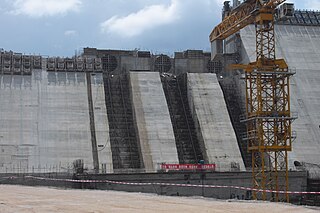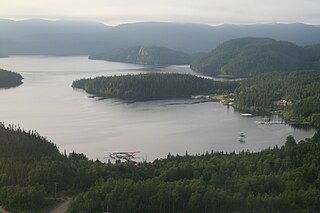
The Ilısu Dam is a concrete-face rock-fill dam on the Tigris near the village of Ilısu and along the border of Mardin and Şırnak Provinces in Turkey. It is one of the 22 dams of the Southeastern Anatolia Project and its purpose is hydroelectric power production, flood control and water storage. When operational, the dam will support a 1,200 MW power station and will form a 10.4 billion m3 reservoir. Construction of the dam began in 2006 and was originally expected to be completed by 2016. As part of the project, the much smaller Cizre Dam is to be constructed downstream for irrigation and power. The dam has drawn international controversy, because it will flood portions of ancient Hasankeyf and necessitate the relocation of people living in the region. Because of this, the dam lost international funding in 2008. Most historical structures in Hasankeyf were moved to the new Hasankeyf prior to the filling of the dam. The dam began to fill its reservoir in late July 2019. Due to rainfall, the dam has achieved water levels up to 100m above the river bed and stored 5 billion cubic meters of water. The water level had reached an elevation of 498.2m on 1 April 2020.

The Robert-Bourassa generating station, formerly known as La Grande-2 (LG-2), is a hydroelectric power station on the La Grande River that is part of Hydro-Québec's James Bay Project in Canada. The station can generate 5,616 MW and its 16 units were gradually commissioned between 1979 and 1981. Annual generation is in the vicinity of 26500 GWh.
The Temengor Dam or Temengor Hydro-Electric Project or Temengor Power Station is a dam in Gerik, Perak, Malaysia. It is located on Perak River about 200 km northeast of Ipoh. Construction of the dam impounded Temenggor Lake.

The Bui Dam is a 400-megawatt (540,000 hp) hydroelectric project in Ghana. It is built on the Black Volta river at the Bui Gorge, at the southern end of Bui National Park. The project is a collaboration between the government of Ghana and Sino Hydro, a Chinese construction company. Construction on the main dam began in December 2009. Its first generator was commissioned on 3 May 2013, and the dam was inaugurated in December of the same year.

The Tsankov Kamak Hydroelectric Power Plant, also Tsankov Kamak HPP, comprises an arch dam and hydroelectric power plant (HPP) in Tsankov Kamak, southwestern Bulgaria. It is situated on the Vacha River in Smolyan Province, on the borders of Pazardzhik Province and Plovdiv Province, roughly 40 kilometres (25 mi) southwest of Plovdiv and downstream (north) of the town of Devin. It is a part of the Dospat-Vacha cascade development of the Vacha River involving five dams and power stations within the Devin municipality, 250 kilometres (160 mi) southeast of Sofia. The other four dams are Dospat Dam, Teshel Dam, the Vacha Dam and the Krichim Dam.

The Samanala Dam is a dam primarily used for hydroelectric power generation in Sri Lanka. Commissioned in 1992, the Samanalawewa Project is the third-largest hydroelectric scheme in the country, producing 405 GWh of energy annually. It was built with financial support from Japan and the United Kingdom. It is notable for a large leak on its right bank. Power production continues as planned despite the leakage, and the water from the leak now provides two thirds of the water issued by the reservoir for agriculture in downstream areas.
The Bekhme Dam is an unfinished multi-purpose rock-fill dam on the Great Zab 60 kilometres (37 mi) northeast of Erbil, in the Erbil Governorate of Kurdistan Region, Iraq.

Zengwen Dam, also spelled Tsengwen Dam, is a major earthen dam in Dapu Township, Chiayi County, Taiwan on the Zengwen River. It is the third tallest dam in Taiwan, and forms Zengwen Reservoir (曾文水庫), the biggest reservoir in Taiwan by volume. The dam stores water for irrigation of the Chianan Plain, Taiwan's most productive agricultural region, and provides flood control along the Zengwen River which flows through Tainan City. The dam supports a 50 megawatt hydroelectric power station.

The Salvajina Dam and hydroelectric plant are located in the Cauca River, corregimiento Buenos Aires, municipality Suarez, department Cauca in the southwest of Colombia. Its reservoir has a length of 31 kilometres (19 mi).

La Esmeralda Dam is an embankment dam on the Batá River northwest of Santa María in Boyacá Department, Neira Province, Valle de Tenza Colombia, 52 km to south of Tunja city. The primary purpose of the dam is hydroelectric power production and it is part of the Chivor Hydroelectric Project. Water from the Batá is diverted by the dam to a power station that discharges to the Lengupá River. The power station supplies 8% of Colombia's power demand.

The El Quimbo Dam is a concrete faced rock-fill dam (CFRD) and hydroelectric power facility in the Huila Department of southwestern-central Colombia, approximately 69 kilometres (43 mi) south of the city of Neiva, on the Magdalena River. It is located about 1,300 metres (4,300 ft) upstream from the confluence of the Páez River with the Magdalena River. Its works were officially opened on February 25, 2011 in the presence of President Juan Manuel Santos. It is one of the largest infrastructure projects in the country. The project was completed 4 years later, in the end of 2015.

Lake Cachi is an artificial lake in central Costa Rica created by the Cachí Dam, an arch dam north of Tapantí National Park, to the east-southeast of Cartago in Cartago Province. The main town is Cachí, away from the east bank of the lake. Built in the 1970s, it was one of the first hydroelectric projects in Costa Rica. It has an installed capacity of 102 MW with three units of 34 MW capacity each.

The Miel I Dam, officially known as the Patángoras Dam, is a gravity dam on La Miel River just south of Norcasia in Caldas Department, Colombia. The dam was constructed between 1997 and 2002 for the primary purpose of hydroelectric power generation. At the time of its completion, the dam was the tallest roller-compacted concrete (RCC) dam in the world but was surpassed by the Longtan Dam in 2009.
The Punchiná Dam is an embankment dam on the Guatapé River 17 kilometres (11 mi) east of San Carlos in Antioquia Department, Colombia. The dam creates Punchiná Reservoir which is part of the 1,240 megawatts (1,660,000 hp) San Carlos Hydroelectric Power Plant. The power plant was completed in two 620 megawatts (830,000 hp) stages, the first was completed in 1984 and the second in 1987. It is the largest power station in Colombia.
The Porce III Dam is an embankment dam on the Porce River 90 kilometres (56 mi) northeast of Medellín in Antioquia Department, Colombia. The dam was constructed between 2004 and 2011 for the primary purpose of hydroelectric power generation.

The Sogamoso Dam is a concrete-face rock-fill dam on the Sogamoso River in northern Colombia. It is located 30 kilometres (19 mi) west of Bucaramanga in Santander Department and 285 kilometres (177 mi) north of Bogotá. The primary purpose of the dam is hydroelectric power generation and its power plant has an installed capacity of 820 megawatts (1,100,000 hp) which increased Colombia's generating capacity by 10 percent. Construction on the dam began in February 2009 and its first 273 MW Francis turbine-generator was commissioned on 1 December 2014. The other two generators were operational by 20 December 2014. The US$1.74 billion dam and power plant is owned by ISAGEN. INGETEC designed the dam in the 1990s and Impreglio was awarded the contract for construction.
The Toulnustouc generating station, is a hydroelectric power generating station managed by Hydro-Québec on the Toulnustouc River in the territory of Côte-Nord, Quebec, Canada. It has an installed capacity of 526 MW. The power station is fed by water from a dam and dyke that contain the Lake-Sainte-Anne reservoir.

Lake Sainte-Anne is a lake and reservoir on the Toulnustouc River in the territory of Côte-Nord, Quebec, Canada. The original dam was built in 1950 to regulate the river flow as part of the Manicouagan River hydroelectric power complex. A new dam was completed in 2005 that enlarged the reservoir and supported the new Toulnustouc generating station.

The Rizzanese Reservoir is a reservoir in the Corse-du-Sud department of France on the island of Corsica. It stores water for irrigation, and supplies the largest hydroelectric power plant in Corsica, with installed capacity of 55 MW.

Isabel Cristina Zuleta López is a Colombian activist and politician. An outspoken advocate for environmental causes, women's rights, and human rights, she was director of the Living Rivers movement in Antioquia, and belongs to the Movement for Water and Life. She is best known for her work as a social leader in communities opposed to the Ituango Dam project.
















